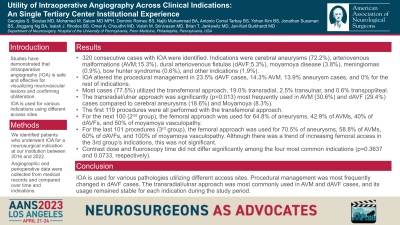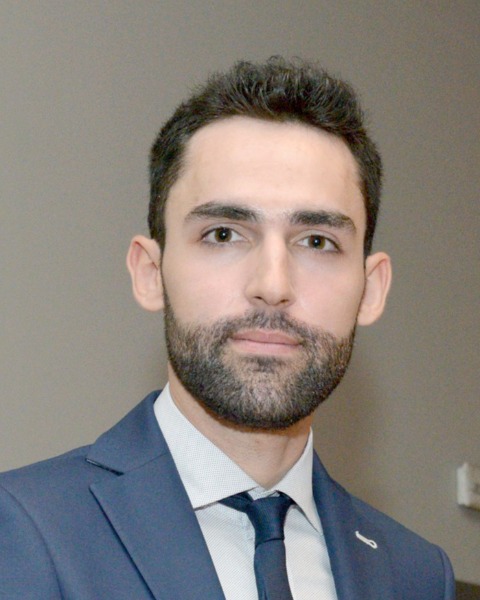Utility of Intraoperative Angiography Across Clinical Indications: An Single Tertiary Center Institutional Experience
Friday, April 21, 2023


Georgios S. Sioutas, MD (he/him/his)
Postdoc Research Fellow
Department of Neurosurgery, Hospital of the University of Pennsylvania, Penn Medicine, Philadelphia, Pennsylvania, USA
Philadelphia, PA, US
ePoster Presenter(s)
Introduction: Studies have demonstrated that intraoperative angiography (IOA) is safe and effective for visualizing neurovascular lesions and confirming obliteration. IOA is used for various indications using different access sites.
Methods: We identified patients who underwent IOA for a neurosurgical indication at our institution between 2016 and 2022. Angiographic and perioperative data were collected from medical records and compared over time and indications.
Results: 320 consecutive cases with IOA were identified. Indications were cerebral aneurysms (72.2%), arteriovenous malformations (AVM;15.3%), dural arteriovenous fistulas (dAVF;5.3%), moyamoya disease (3.8%), meningiomas (0.9%), bow hunter syndrome (0.6%), and other indications (1.9%). IOA altered the procedural management in 23.5% dAVF cases, 14.3% AVM, 13.9% aneurysm cases, and 0% for the rest of indications. Most cases (77.5%) utilized the transfemoral approach, 19.0% transradial, 2.5% transulnar, and 0.6% transpopliteal. The transradial/ulnar approach was significantly (p=0.013) most frequently used in AVM (30.6%) and dAVF (29.4%) cases compared to cerebral aneurysms (18.6%) and Moyamoya (8.3%). The first 119 procedures were all performed with the transfemoral approach. For the next 100 (2nd group), the femoral approach was used for 64.8% of aneurysms, 42.9% of AVMs, 40% of dAVFs, and 50% of moyamoya vasculopathy. For the last 101 procedures (3rd group), the femoral approach was used for 70.5% of aneurysms, 58.8% of AVMs, 60% of dAVFs, and 100% of moyamoya vasculopathy. Although there was a trend of increasing femoral access in the 3rd group’s indications, this was not significant. Contrast dose and fluoroscopy time did not differ significantly among the four most common indications (p=0.3637 and 0.0733, respectively).
Conclusion : IOA is used for various pathologies utilizing different access sites. Procedural management was most frequently changed in dAVF cases. The transradial/ulnar approach was most commonly used in AVM and dAVF cases, and its usage remained stable for each indication during the study period.
Methods: We identified patients who underwent IOA for a neurosurgical indication at our institution between 2016 and 2022. Angiographic and perioperative data were collected from medical records and compared over time and indications.
Results: 320 consecutive cases with IOA were identified. Indications were cerebral aneurysms (72.2%), arteriovenous malformations (AVM;15.3%), dural arteriovenous fistulas (dAVF;5.3%), moyamoya disease (3.8%), meningiomas (0.9%), bow hunter syndrome (0.6%), and other indications (1.9%). IOA altered the procedural management in 23.5% dAVF cases, 14.3% AVM, 13.9% aneurysm cases, and 0% for the rest of indications. Most cases (77.5%) utilized the transfemoral approach, 19.0% transradial, 2.5% transulnar, and 0.6% transpopliteal. The transradial/ulnar approach was significantly (p=0.013) most frequently used in AVM (30.6%) and dAVF (29.4%) cases compared to cerebral aneurysms (18.6%) and Moyamoya (8.3%). The first 119 procedures were all performed with the transfemoral approach. For the next 100 (2nd group), the femoral approach was used for 64.8% of aneurysms, 42.9% of AVMs, 40% of dAVFs, and 50% of moyamoya vasculopathy. For the last 101 procedures (3rd group), the femoral approach was used for 70.5% of aneurysms, 58.8% of AVMs, 60% of dAVFs, and 100% of moyamoya vasculopathy. Although there was a trend of increasing femoral access in the 3rd group’s indications, this was not significant. Contrast dose and fluoroscopy time did not differ significantly among the four most common indications (p=0.3637 and 0.0733, respectively).
Conclusion : IOA is used for various pathologies utilizing different access sites. Procedural management was most frequently changed in dAVF cases. The transradial/ulnar approach was most commonly used in AVM and dAVF cases, and its usage remained stable for each indication during the study period.
